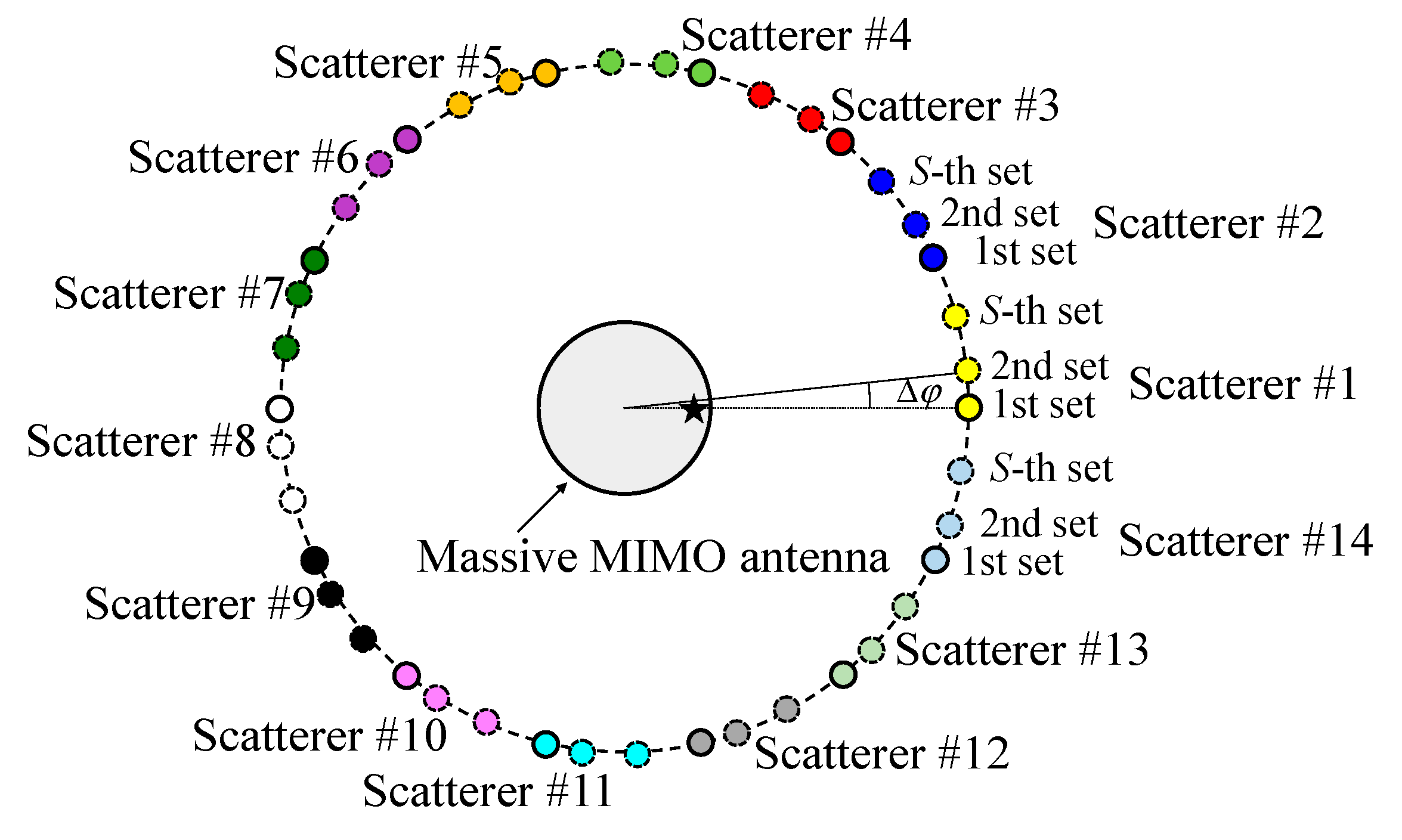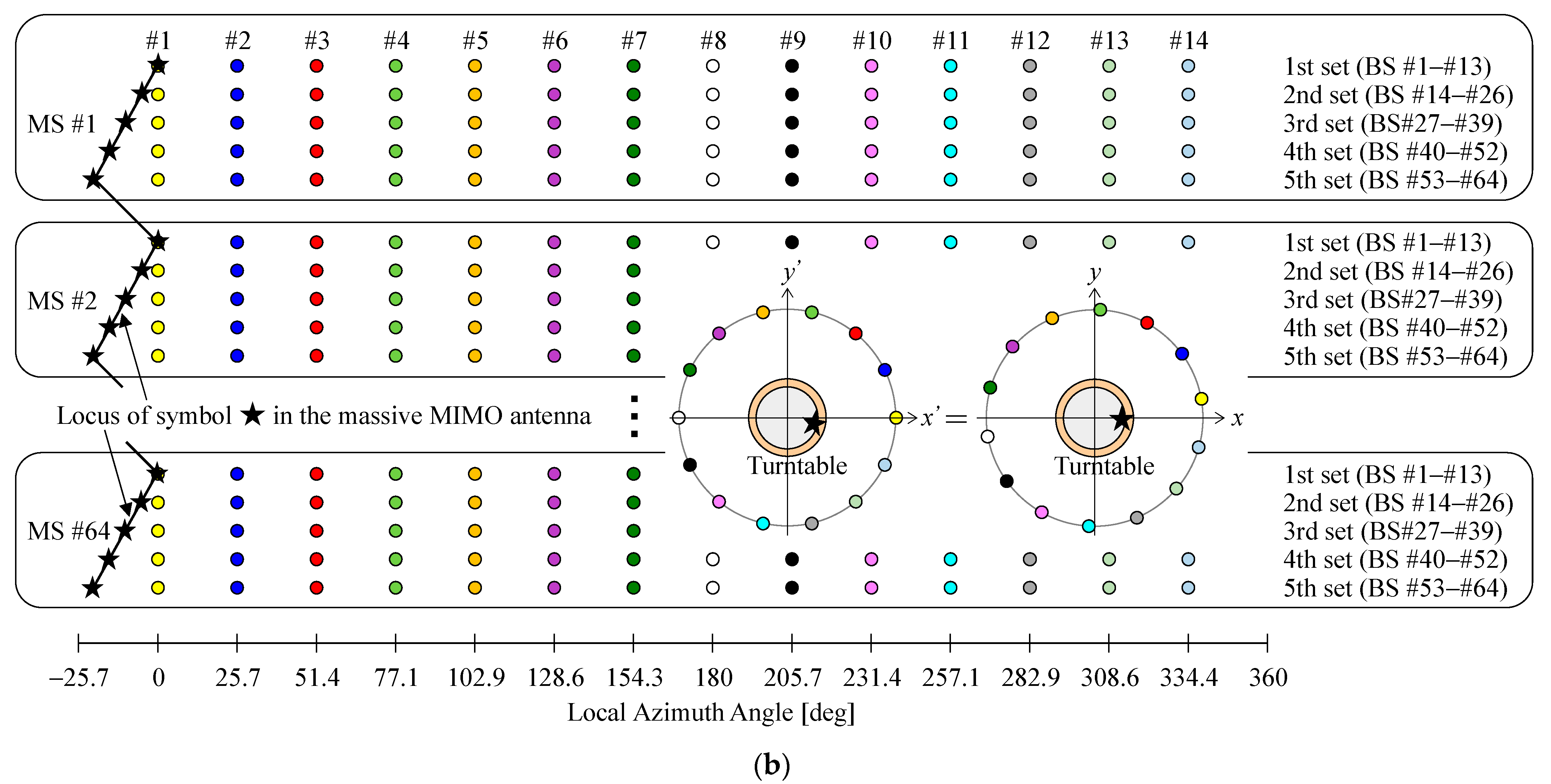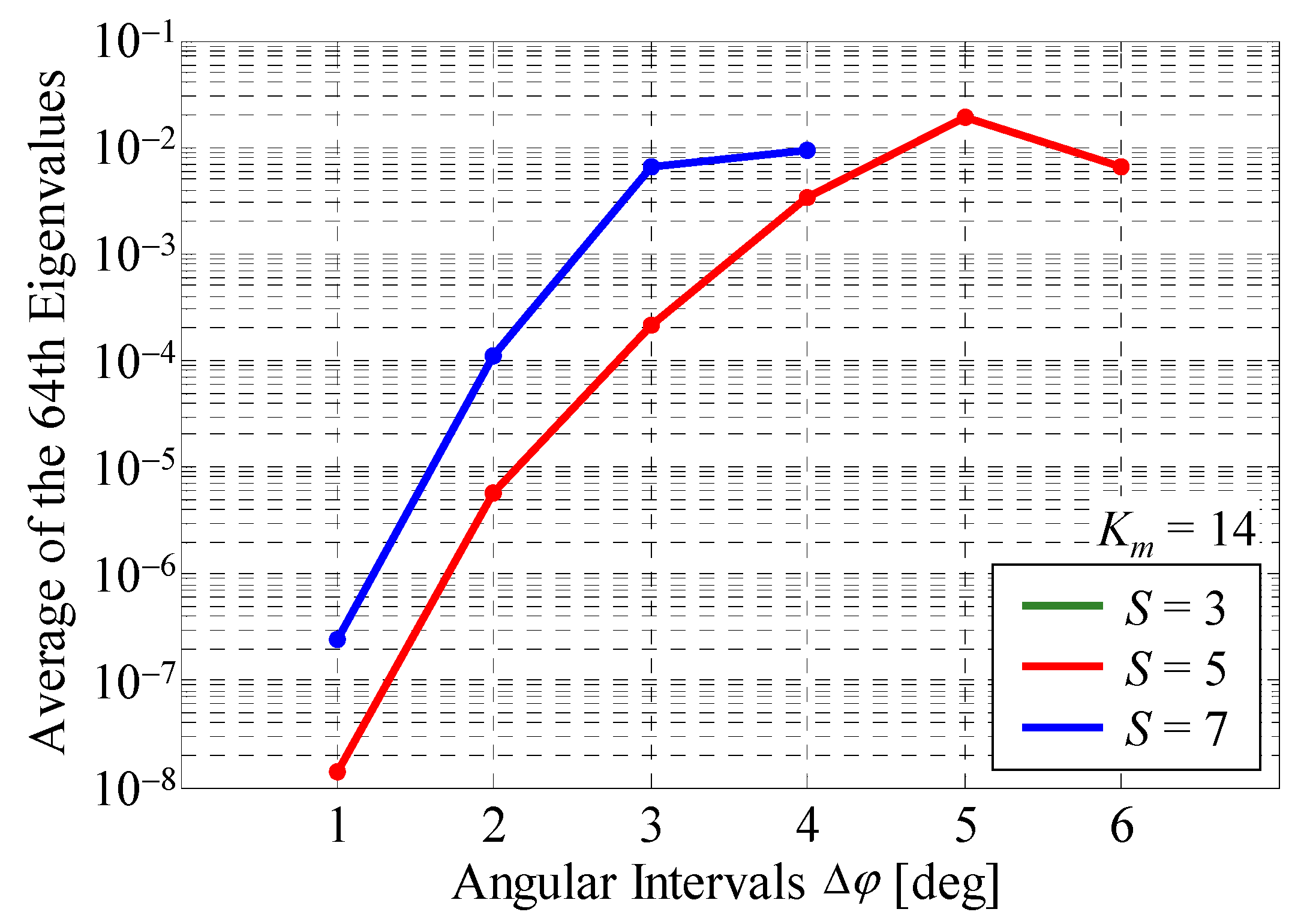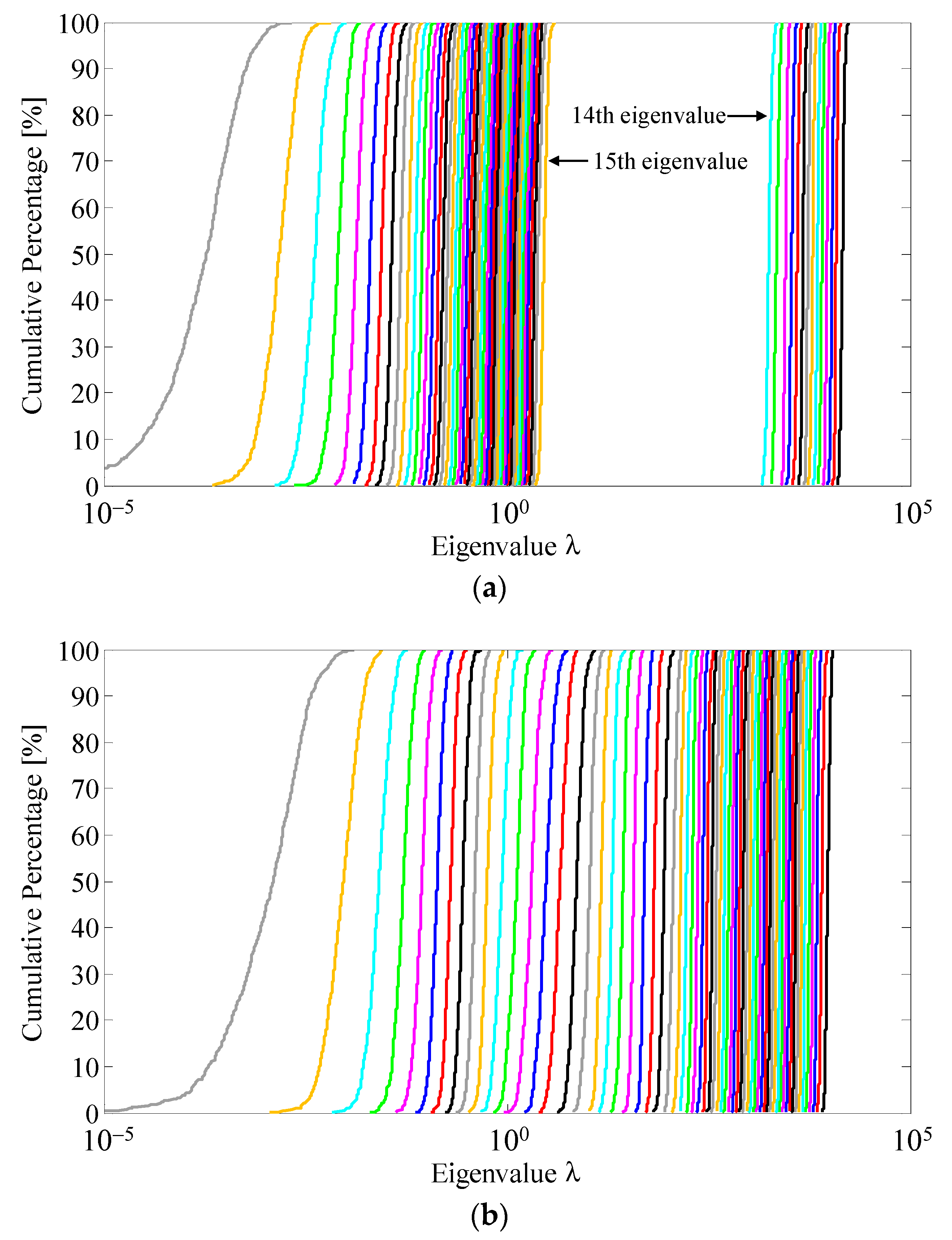1. Introduction
Global commercial services for ultra-high speed fifth-generation (5G) mobile communication using multiple-input multiple-output (MIMO) systems are currently available [
1,
2]. One of the possible solutions to significantly enhance the channel capacity of MIMO systems is to utilize a large number of antenna elements for both the base station (BS) and the mobile station (MS). Such a system is called a massive MIMO system [
3].
Most of the activity so far undertaken in developing massive MIMO systems has been directed toward providing large-scale MIMO antennas at the BS, with antennas comprising more than 100 antenna elements [
4,
5], and there are few reports of doing something similar at the MS [
6]. The author is currently developing a method to achieve a large-scale MIMO antenna system that maintains an invariable channel capacity over the full-azimuth at the MS, such as, for example, a connected ground-based or flying car [
7].
The usual technique for evaluating the performance of MIMO antennas with multipath fading channels is to do Monte Carlo simulation where several scatterers are placed on a circle [
8,
9]. This is known as the Clarke model or ring model. Using this model, the number of scatterers required to simulate the full-rank property of the channel matrix for a massive MIMO system is greater than the number of subchannels.
To analyze the capability of the developed antenna [
7], the author proposed a Monte Carlo simulation with randomly arranged scatterers [
10]. A small number of differently positioned scatterers were set for each BS antenna using random numbers, confirming that the channel matrix created can achieve full-rank status similar to conventional Monte Carlo simulation. However, a large number of scatterers are necessary to emulate a lot of channels.
A legitimate manner of assessing the performance of a fabricated massive MIMO antenna is to test it in the field [
11]. However, with field testing, the measurements are neither repeatable nor controllable, and, moreover, the measurement process is considerably time-consuming and labor-intensive. Hence, over-the-air (OTA) testing, which evaluates the ability of a MIMO antenna by reproducing a realistic multipath radio propagation environment in the laboratory, is essential.
A proper OTA testing method for massive MIMO antennas is required to accelerate the development and optimization of the antenna [
12]. As many massive MIMO BS antennas have been developed, radiating evaluation methods for massive MIMO BS antennas using fading emulators have also been investigated [
13,
14]. Many BS antennas comprise a two-dimensional planar array antenna with a number of patch antennas. Consequently, a large number of scatterers are placed in a limited direction with respect to the OTA apparatus and scatterers are selected from among them for the assessment.
On the other hand, an OTA testing method for massive MIMO MS antennas is not currently available. A fading emulator with a small number of scatterers placed on a circle has been adopted for proper OTA testing of a handset MS comprising a few MIMO antenna elements [
15,
16]. In the standard method utilizing a fading emulator, the arrangement of the scatterers depends on the number of subchannels, indicating that a large number of scatterers are necessary to assess the performance of a massive MIMO system with a full-rank channel matrix. Therefore, because of the size and cost of the equipment, the standard method is not effective for massive MIMO MS antennas.
The author proposed an OTA evaluation method for a massive MIMO antenna that creates a full-rank channel matrix [
17]. The results of the Monte Carlo simulation, which included simulation of the proposed OTA testing method, revealed that even though the channel model comprised a limited number of scatterers, a full-rank channel matrix can be created. However, an experimental verification of this has not been done.
This paper presents an experimental verification of the proposed method utilizing a two-dimensional fading emulator with a small number of scatterers. In the OTA measurements, the massive MIMO MS antenna is located at the center of the fading emulator and is rotated depending on the measured channel response at the BS antenna, in such a way that a small number of scatterers are equivalent to a much larger number of scatterers. The experimental results showed that the number of available eigenvalues is greater than that obtained with the previous method.
2. Measurement Method of the Full-Rank Channel
In a previous Monte Carlo simulation with a uniform arrangement of scatterers, which represented the secondary wave source,
N ×
M channel responses were calculated to form Equation (1).
where
Km indicates the number of actual scatterers.
M and
N denote the number of elements in the BS and MS, respectively. Furthermore, the author assumed that the number of elements at the BS is equal to that at the MS, that is,
M =
N.
In Equation (1), because all the signals from the
M elements at BS overlap with each other at the same location, the number of columns that satisfy linear independence is equal to
Km in the channel model. Consequently, assuming that
Km is less than
M, Equation (1) is transformed into Equation (2) using diagonalization.
Therefore, the eigenvalue vector obtained using singular value decomposition (SVD) is denoted by Equation (3).
The rank of Equation (2) equals Km which is less than M, indicating a rank-deficient status. Consequently, the number of eigenvalues, that is, the number of channels, observed is only Km. Hence, a large number of scatterers, greater than M, are necessary to obtain full-rank status with rank (HS) = M.
The method of randomly arranged scatterers, in which a limited number of scatterers are arranged to simulate each BS element, was proposed [
10]. The required number of scatterers to generate the Rayleigh fading environment for one BS element is small. However, the total number of scatterers is the product of
M and
Km. Consequently, for OTA testing of a massive MIMO system incorporating the method of randomly arranged scatterers, a small number of scatterers must be selected from among the large number of scatterers on the circle of the fading emulator. Otherwise, the actual scatterers need to be relocated for each BS. Hence, the OTA testing implemented using the method of randomly arranged scatterers is extremely labor-intensive process compared with the standard OTA testing method.
The author proposed an OTA testing method in which the scatterers are virtually formed emulating a large number of scatterers [
17].
Figure 1 shows the configuration of the proposed fading emulator to enable a full-rank channel matrix for a massive MIMO antenna. In
Figure 1,
Km, that is, the number of scatterers in the 1st set, is 14 which is sufficient to produce a Rayleigh fading environment. The 2nd to
S-th sets of scatterers are virtually placed, where
S indicates the number of scatterer sets.
The angular intervals between the
i-th and (
i + 1)-th sets of scatterers, Δ
φ, as shown in
Figure 1, are the same. Therefore, each set of scatterers is formed by rotating the 1st set of scatterers. Consequently, the placement of each of scatterer differs, and a large number of scatterers can be emulated, with the expectation that measurement with a full-rank property of the channel matrix can be achieved.
The most important parameter in the measurement is the number of scatterer sets which depends on the number of actual scatterers. Independent paths via each BS antenna are generated by orthogonal initial phase sets at the actual scatterers. Hence, the maximum number of BS elements emulated in accordance with each set of scatterers is the same as the number of actual scatterers. In order to achieve a full-rank matrix,
S must be adjusted to be greater than
M divided by
Km. Another important parameter is Δ
φ. If Δ
φ is small, the possibility of generating different paths from adjacent sets of scatterers is small. In this paper, Δ
φ is set to equal angular intervals, and it is calculated as follows:
There are two ways to construct the fading emulator embodied using the proposed method. One of the possible ways is to rotate the turn rail on which the actual scatterers are located, as shown in the insert in
Figure 2a, which is the same structure shown in
Figure 1. Another is that the massive MIMO antenna, which is placed at the center of the turntable, is rotated, as illustrated on the left hand side of the inset in
Figure 2b. In this case, the rotation target, that is, the massive MIMO antenna, is different to that of
Figure 1, but
Figure 1 and
Figure 2b have the same benefit of achieving a full-rank channel matrix measurement, as explained in below.
It is known that with multiple probe antenna based methods, such as those with fading emulators, the repeatability and controllability of the radio propagation environment are superior to those obtained with other OTA testing methods, such as reverberation chamber based methods or two-stage methods [
18]. In OTA assessment using a fading emulator, the MIMO channel response between the
m-th BS antenna element and
n-th MS antenna element is measured individually, taking advantage of the high time correlation characteristics of the apparatus.
Figure 2 shows the relationship between the channel response measured, the azimuth angle of the actual scatterers, and the azimuth angle of the massive MIMO antenna in the case of a 64 × 64 MIMO system, with
Km = 14, and
S = 5. The symbols in
Figure 2 are associated with
Figure 1. The circles indicate the positions of the scatterers, whereas the star symbol denotes the azimuth angle of the massive MIMO antenna, which starts from 0° in the measurements.
In
Figure 2a, the massive MIMO MS antenna is fixed at the center of the fading emulator, and the actual scatterers are moved by rotating the turn rail. Accordingly, the global azimuth angle of the scatterers is varied depending on the measured channel response for the
m-th BS antenna. The black line indicates the locus of scatterer #1.
The channel responses from BS #1 to BS #13 are measured with the 1st set of scatterers in place. Then, the turn rail is rotated by Δφ, and the channel responses from BS #14 to BS #26 are measured with the 2nd set of scatterers in place. By repeating this procedure, the channel responses of the n-th MS antenna are fulfilled. Moreover, this method applies to all MS antennas, resulting in a full-rank channel response matrix.
In contrast, in
Figure 2b, the actual scatterers remain stationary, and the turntable with the massive MIMO MS antenna is rotated. Consequently, the local azimuth angle of the massive MIMO MS antenna is changed corresponding to the measured channel response for the
m-th BS antenna. The black line shows the locus of the star symbol expressing the angle of the massive MIMO antenna. However, the global azimuth angle of the MIMO antenna is fixed during OTA testing. When the local azimuth angle is transformed so that the global azimuth angle is 0°, as shown on the right hand side of the inset in
Figure 2b, it becomes the same as in
Figure 2a. Eventually, the actual scatterers are virtually positioned in different locations.
The channel responses from BS #1 to BS #13 are measured. Then, the turntable is rotated by −Δφ, and the channel responses from BS #14 to BS #26 are obtained. By repeating this operation, the channel responses of the n-th MS antenna are satisfied. Furthermore, this is done for all MS antennas, demonstrating that the channel matrix is full-rank status.














